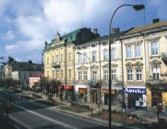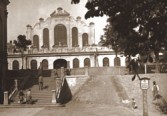


It has been confirmed that this church dates back to the second half of
the 15th century and is among the oldest places of worship in Jarosław.
In the beginning, this was a hospital chapel - at that time asylums for
poor, lonely or sick people were called hospitals. In the second half
of the 17th century, in the place of the wooden chapel a small brick
church was erected. Soon after the first Partition of Poland it was
purchased by Evangelicals and turned into a Protestant church. After
World War II, the building was returned to its original function of a
Latin church.
Once you have entered the city through the Cracow Gate, you stand on the main street of historical Jarosław. The present-day Grodzka Street, called in the 16th century Niemiecka (German) and later Krakowska (Cracow), through its architecture and the style of the burgher houses, will take you back to the glorious days of the city.
Because of the limited space, it is difficult now to imagine that in the past all burgher houses had arcades and at least some of them had attics. The buildings, decorated with portals, sgrafittos (there is a partly preserved 17th century sgrafitto on burgher house no. 10) and with rich stuccowork and polychromes inside (17th century polychrome on the ground floor in burgher house no. 4) belonged to affluent citizens of Jarosław.

The presbytery was located in the present-day Krakowska Street,
opposite to the Collegiate Church of All Saints. Nowadays, this area is
occupied by the Market Hall erected in the first quarter of the 20th
century. It was designed to resemble the Market Hall in Wrocław with a
vivid design of the facades adorned with motifs modelled on the Polish
attic style. It plays a very important functional role.
In the past it used to be the "belly" of the city, but nowadays it has become to a larger extent a place of retail trade.
On the same side of the street going in the direction of the Gate, you will discover a picturesque passageway called in the past "miedzuch". This passage will take you to the 19th century (second half) Jarosław park situated on the former location of the walls and moat. A small obelisk has been dedicated to the park's founder - Ferdynand Wenzel. It is located between the old City Watch-tower, presently a building belonging to the Economic School Complex, from the right and a building erected at the beginning of the 20th century for the Jewish Association "Yad Charyjcym" (currently the Municipal Public Library and the Ballet Centre can be found there) on the left.
Krystyna Kieferling, Zofia Kostka-Bieńkowska